
a web page by Don Roberson |
JACAMARS Galbulidae |
||
|
||
A good many jacamars are glistening green above with red or rufous bellies. Singles or pairs are most often found at tree-falls, clearings, or edges, where they sally out after flying insects. Dragonflies and bees are among the favorites. A good example, and the largest species in the family, is Great Jacamar (left). And in this photo, it has just caught a large bee! Great Jacamar is one of only two species that are assigned to a monotypic genus. It is widespread in the Amazon Basin, and it also occurs in the lowland forests on the Caribbean slope of Central America, and the Pacific slope of Colombia. While its coloration recalls many others in the family, its rufous coloration on the belly extends to the back in some races, and it has a much heavier and somewhat down-curved bill. |
||
The most speciose genus is Galbula, with 10 species. Surely the best known and most widespread member of genus Galbula is Rufous-tailed Jacamar (two photos below: front and back of same individual roosting after a rain). It is glistening green above with a green breast, white throat, and rufous belly and undertail. It occurs in a wide variety of humid lowland forests from eastern Mexico to Bolivia but it is not in the Amazon Basin where there is a variety of other species. This individual was roosting at eye-level low in a gallery forest along a creek in the Brazilian Pantanal. |
||
|
||
Another eight jacamars are small and shorter-tailed species found in northern or western South American lowlands. While most Galbula jacamars forage at low elevations in the forest, Paradise Jacamar G. dea is quite different, both in habitat and plumage. Paradise Jacamar is primarily a canopy species in the Amazon Basin and the Guianas. It looks all-black from a distance but more a contrasting white throat and upper breast, but at close range shows metallic bluish-black sheen to upperparts, and has a long, pointed tail. Three-toed Jacamar Jacamaralcyon tridactyla is an endangered species in the Atlantic coastal forests of southeast Brazil. It is small, rather dingy in appearance, and has only three toes on each foot. Like puffbirds, jacamars excavate nest burrows in arboreal termitarias in which to lay their eggs (Tobias 2002). |
||
Dusky-backed Jacamar (left) has very small range in the lowlands of eastern Panama and adjacent northwest Colombia. It has an exceptionally long bill for its size, and occurs in somewhat disturbed areas, such as recent burns. There, it may be found in pairs or small family groups, chasing flying insects from exposed, high perches. During our limited time near the end of the Pan-American Highway in eastern Panama, our guide learned from locals of a pair at a site that could be reached only by river. So off we went in dugout canoes with small motors, for a wet landing on the shores of winding river in extensive forest, and were rewarded with nice views of a pair (this is the male of that pair). The most widespread example of the genus is Brown Jacamar (below, in nice Arthur Grosset photo). This species ranges into more open savanna woodlands than those others that reside only in forests. |
||
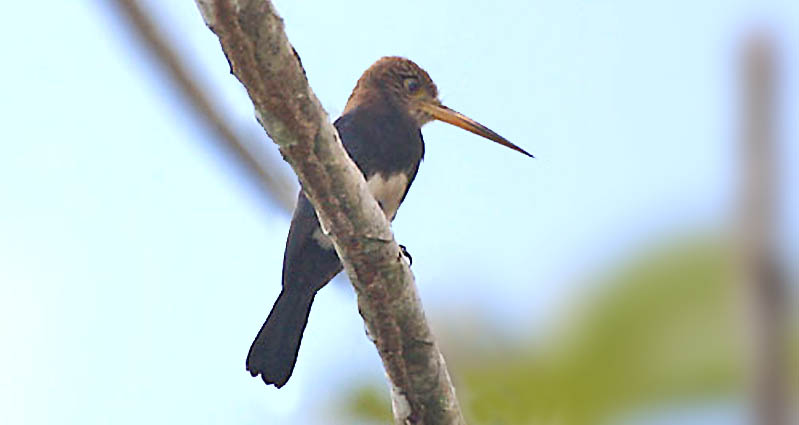 |
||
Photos: The bee-catching Great Jacamar Jacamerops aureus was along Pipeline Road, Panama, on 16 Feb 2022. The two shots of Rufous-tailed Jacamar Galbula ruficauda were along the Rio Claro in the Brazilian Pantanal on 19 July 2010. David Fisher photographed the Yellow-billed Jacamar Galbula albirostris at Junglaven, Venezuela, in March 2007. The Dusky-backed Jacamar Brachygalba salmoni was along the Rio Turquesa in eastern Panama, on 15 Feb 2022. Arthur Grosset photographed the Brown Jacamar Brachygalba lugubris in Thaimaçu, Pará, Brazil, in April 2003.
Bibliographic note: There is no "family book" per se but a solid introduction to this family, with some lovely photos, is in Tobias (2002). Literature cited:
|
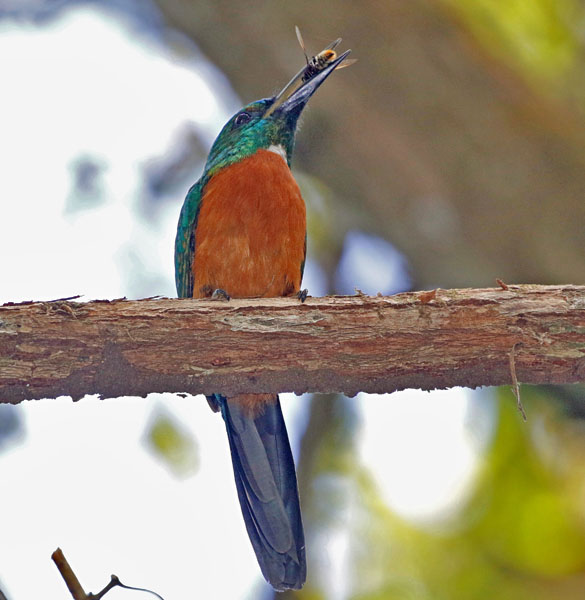 The Jacamars are a small family of sit-and-pursue predators in forests of the Neotropics. There are five genera in the family but all jacamars are easily recognized as members of the Galbulidae by their long, straight, thin and sharply-pointed bill; their generally colorful plumage; their slim, small-headed shape; and, for a number of species, a long thin tail. The closest relatives to Jacamars are Puffbirds [Bucconidae] and together they form the Order Galbuliformes. Both jacamars and puffbirds are Neotropical sit-and-wait forest birds but jacamars have (mostly) long bills while puffbirds have (mostly) short, broad bills. These two families diverged about 36 million years ago (Prum et al. 2015).
The Jacamars are a small family of sit-and-pursue predators in forests of the Neotropics. There are five genera in the family but all jacamars are easily recognized as members of the Galbulidae by their long, straight, thin and sharply-pointed bill; their generally colorful plumage; their slim, small-headed shape; and, for a number of species, a long thin tail. The closest relatives to Jacamars are Puffbirds [Bucconidae] and together they form the Order Galbuliformes. Both jacamars and puffbirds are Neotropical sit-and-wait forest birds but jacamars have (mostly) long bills while puffbirds have (mostly) short, broad bills. These two families diverged about 36 million years ago (Prum et al. 2015). 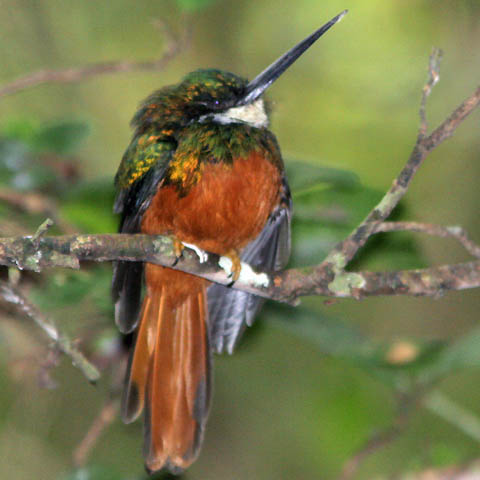

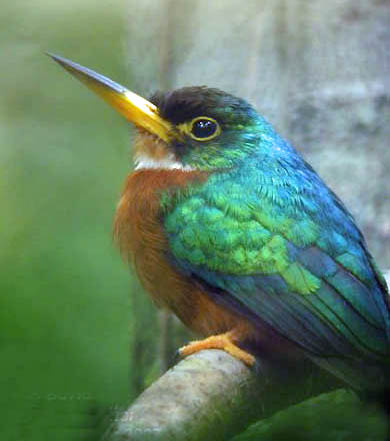 Yellow-billed Jacamar (right in a lovely shot by David Fisher) is a small Galbula jacamar that inhabits the interior of primary terra firme and varzea forests north of the Amazon and through the Guianas. It frequents lower levels of the forest, just 1-10 m off the ground and can be quite inconspicuous. David Fisher's photo does show some of the lovely glittering gloss on crown (dark purple) and upperparts (shining green to rich blue.).
Yellow-billed Jacamar (right in a lovely shot by David Fisher) is a small Galbula jacamar that inhabits the interior of primary terra firme and varzea forests north of the Amazon and through the Guianas. It frequents lower levels of the forest, just 1-10 m off the ground and can be quite inconspicuous. David Fisher's photo does show some of the lovely glittering gloss on crown (dark purple) and upperparts (shining green to rich blue.).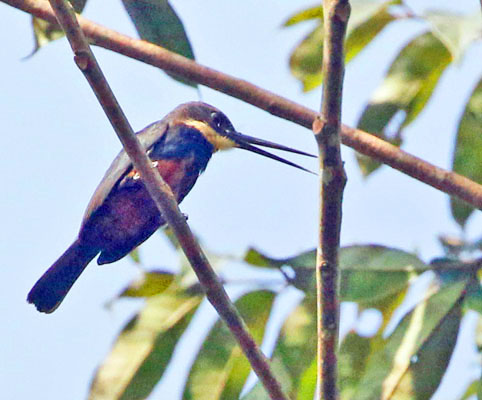 Among small jacamars, White-eared Jacamar Galbalcyrhynchus leucotis and recently described Purus Jacamar G. purusianus are plumaged in rich chestnut. The four small jacamars in genus Brachygalba tend towards more brown and white in their patterns. There is no overlap in range between any of them, and three of the four species occupy small ranges. Pale-headed Jacamar Brachygalba goeringi is another example of a limited-range species, being confined to a relatively tiny area of northeast Colombia and adjacent northwest Venezuela.
Among small jacamars, White-eared Jacamar Galbalcyrhynchus leucotis and recently described Purus Jacamar G. purusianus are plumaged in rich chestnut. The four small jacamars in genus Brachygalba tend towards more brown and white in their patterns. There is no overlap in range between any of them, and three of the four species occupy small ranges. Pale-headed Jacamar Brachygalba goeringi is another example of a limited-range species, being confined to a relatively tiny area of northeast Colombia and adjacent northwest Venezuela.